Welcome to our comprehensive guide on aquarium fish and coral! As fellow enthusiasts, we know firsthand the joy and satisfaction of creating a stunning underwater paradise. Whether you’re a beginner or an experienced hobbyist, this guide has something for everyone. We’ll cover everything from the basics of setting up and maintaining an aquarium to expert tips and tricks for creating show-stopping displays. Let’s dive in!
Key Takeaways:
- This guide covers everything you need to know about aquarium fish and coral.
- From setting up and maintaining an aquarium to expert tips and tricks, we’ve got you covered.
- Whether you’re a beginner or an experienced hobbyist, there’s something for everyone in this guide.
The Beauty of Aquarium Fish and Coral
As aquarium enthusiasts, we all know that having fish and coral in our tanks isn’t just about keeping pets. It’s about creating a visually stunning display that can be enjoyed from the comfort of our own homes. That’s why selecting the right fish tank decorations, live coral for sale, and other accessories are crucial to achieving the perfect look for your aquarium.
When it comes to fish tank decorations, there are numerous options to choose from. From artificial plants to sunken ships, you can create any theme you desire. On the other hand, live coral can add an entirely new dimension to your aquarium. With different colors and shapes available, it’s easy to create a thriving coral reef aquarium that will leave your guests in awe.

But it’s not just about aesthetics. Proper accessories, such as heaters, filters, and lighting, are crucial to maintaining the health and well-being of your fish and coral. By providing the right environment, you can help your aquarium thrive for years to come.
The Benefits of Fish Tank Decorations
Not only do fish tank decorations enhance the visual appeal of your aquarium, but they can also serve as functional hiding spots for your fish. Providing hiding spots and “caves” can help reduce stress levels for your fish, leading to a healthier and happier environment. Additionally, certain decorations, such as rocks and driftwood, can help maintain water quality by providing a surface area for beneficial bacteria to grow.
Choosing the Right Live Coral for Sale
When it comes to selecting live coral, it’s essential to choose the right species for your aquarium and level of experience. Some coral requires more specific lighting or water parameters, while others are hardier and can be easier to maintain. As a beginner, it’s best to start with less challenging species, such as mushroom coral or zoanthids, and work your way up as you gain experience.
With the right fish tank accessories, including live coral and fish tank decorations, you can create a visually appealing and healthy aquarium that will be the envy of all your guests.
Saltwater and Freshwater Aquarium Fish: What You Need to Know
Before we dive into the exciting world of aquarium fish, it’s important to understand the differences between saltwater and freshwater aquariums. The type of fish you want to keep will determine the type of aquarium you need.
Saltwater aquariums are more challenging to maintain than freshwater aquariums, but they offer a more diverse range of species and stunningly vibrant colors. These aquariums require high-quality filtration systems, specialized lighting, and regular water parameter testing. Most saltwater fish species are wild-caught, so they tend to be more expensive than freshwater fish.
On the other hand, freshwater aquariums are much easier and more affordable to maintain. They require less equipment and are ideal for beginners. Freshwater fish come in a wide range of shapes, sizes, and colors, and they are generally less expensive than saltwater fish.
Whether you choose a saltwater or freshwater aquarium, it’s essential to research and select fish that are compatible with each other to avoid aggression and stress. Some common saltwater fish species include clownfish, angelfish, and tangs, while some of the most popular species found in freshwater aquariums include tetras, guppies, and cichlids.
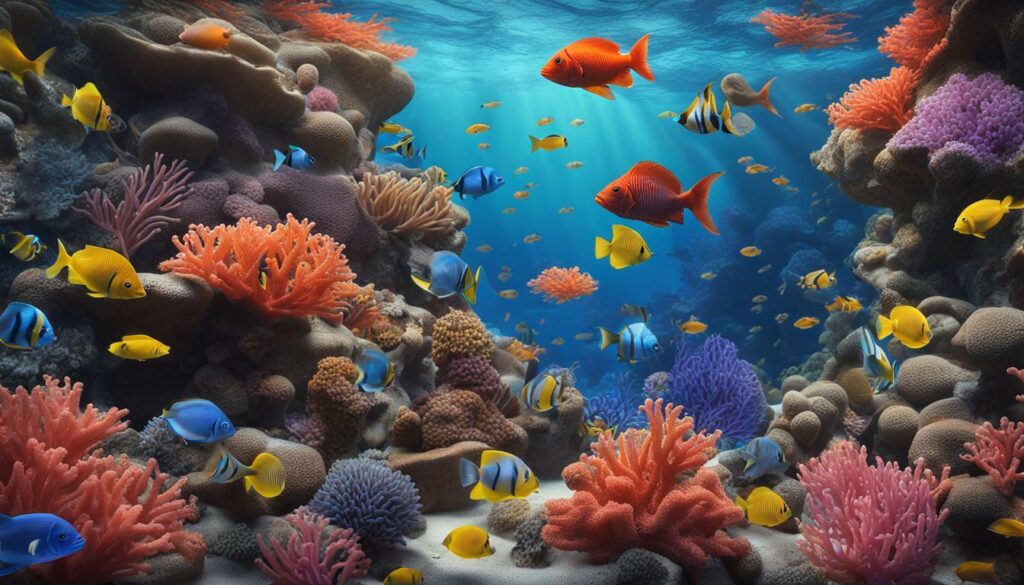
No matter which type of aquarium you choose, it’s important to provide a healthy and stable environment for your fish to thrive. Stay tuned for our next section where we’ll discuss the basics of building a coral reef aquarium.
Creating a Coral Reef Aquarium
Building a coral reef aquarium is a fulfilling and exciting venture that requires patience, knowledge, and attention to detail. It involves setting up an ecosystem that mimics the natural habitat of coral and marine life, creating a stunning underwater world that is not only visually appealing but also conducive to the growth and well-being of the inhabitants.
Before setting up a coral reef aquarium, it’s important to understand the requirements for creating a healthy and thriving ecosystem. You’ll need to purchase a suitable tank size, filtration system, lighting, and other essential equipment. The best coral for beginners are soft corals such as mushroom corals, leather corals, and polyps. These types of corals are less demanding and easier to maintain than hard corals.
Once you have all the necessary equipment, it’s time to set up the aquarium. The first step is to add sand to the bottom of the tank, followed by live rock. This will provide a natural base and a habitat for beneficial bacteria that will break down waste and maintain the water quality.
Next, you’ll need to add saltwater to the tank, following the specific gravity guidelines for the type of aquarium you want to set up. It’s recommended to use RO/DI water and a quality marine salt mix to ensure the water is free of contaminants and provides all the necessary minerals and trace elements for the inhabitants.
After adding water, it’s time to introduce the coral and marine life. It’s important to ensure compatibility among the inhabitants and avoid overcrowding the tank. It’s also essential to regularly monitor the water parameters and maintain the equipment to ensure optimal conditions for the inhabitants.
| Essential Equipment for a Coral Reef Aquarium | |
|---|---|
| 1. Aquarium tank | 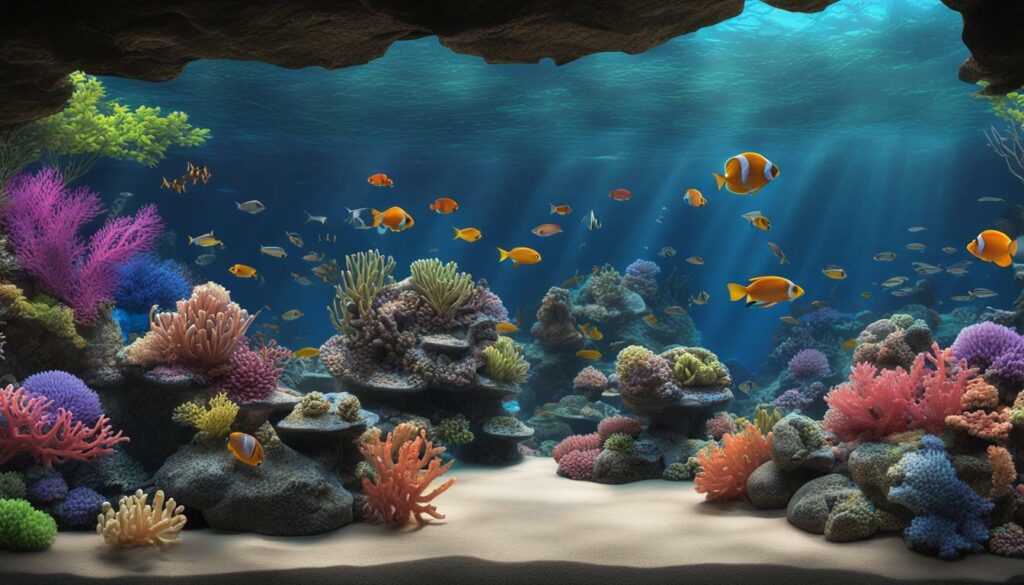 |
| 2. Filtration system | |
| 3. Lighting system | |
| 4. Live rock and sand | |
| 5. Marine salt mix | |
| 6. Thermometer and heater | |
| 7. Water circulation pump | |
| 8. Protein skimmer |
Creating and maintaining a coral reef aquarium requires dedication and attention to detail, but the rewards are tremendous. A well-maintained coral reef aquarium is not only a stunning visual display but also a fascinating ecosystem that provides a glimpse into the wonders of marine life.
Understanding Aquarium Fish Species
At the heart of any aquarium are the fish species that call it home. Choosing the right fish is crucial in ensuring the longevity of your aquarium. In this section, we will explore the different types of aquarium fish available and the unique characteristics of each species.
Tropical Fish for Sale
Tropical fish are a popular choice for aquarium enthusiasts due to their bright colors and playful nature. Some of the most popular tropical fish species include the Neon Tetra, Guppies, and Angelfish. These species are relatively easy to care for and make a fantastic addition to any aquarium.
If you are looking for a more exotic option for your aquarium, the Betta fish is a stunning choice. They come in a range of colors and are beautiful to watch as they gracefully move through the water.
Aquarium Fish Species Compatibility
When choosing your aquarium fish, it’s essential to consider species compatibility. Some fish species may not get along well with others and may become aggressive. To ensure harmony in your aquarium, research and select fish species that can coexist peacefully with one another.
It’s also crucial to consider the size of your fish when selecting species. Some species can grow quite large and may require a larger tank to thrive. Be sure to choose fish that are suitable for the size of your aquarium.
Specific Care Requirements
Each species of aquarium fish has specific care requirements that must be met to ensure their health and well-being. For example, the Discus fish requires a specific water temperature and pH levels to thrive, while the Goldfish may need a balanced diet to prevent swim bladder disease.
Research the care requirements for each species of fish in your aquarium to ensure you are meeting their needs. Proper care and attention will help your fish thrive and lead a happy life in their underwater paradise.

Caring for Aquarium Fish and Coral
Proper care and maintenance are essential for the health and well-being of aquarium fish and coral. Here are some tips to ensure your aquatic pets thrive:
| Aspect | Recommendation |
|---|---|
| Water quality | Regularly test the water and make necessary adjustments to pH, temperature, and salinity levels. Perform partial water changes every 1-2 weeks to remove waste and replenish essential nutrients. |
| Feeding | Provide a balanced and varied diet that meets the nutritional needs of your fish and coral. Feed smaller portions more frequently to prevent overfeeding and maintain water quality. |
| Breeding | If you plan to breed fish in your aquarium, research the specific requirements and provide ample space and appropriate conditions for spawning and rearing offspring. |
| Fish tank accessories | Clean and maintain fish tank accessories such as filters, heaters, and lighting systems regularly to prevent malfunctions and ensure optimal performance. |
Remember: aquarium fish and coral are delicate creatures that require consistent care and attention. By following these tips, you can create a healthy and vibrant underwater ecosystem that both you and your pets can enjoy.
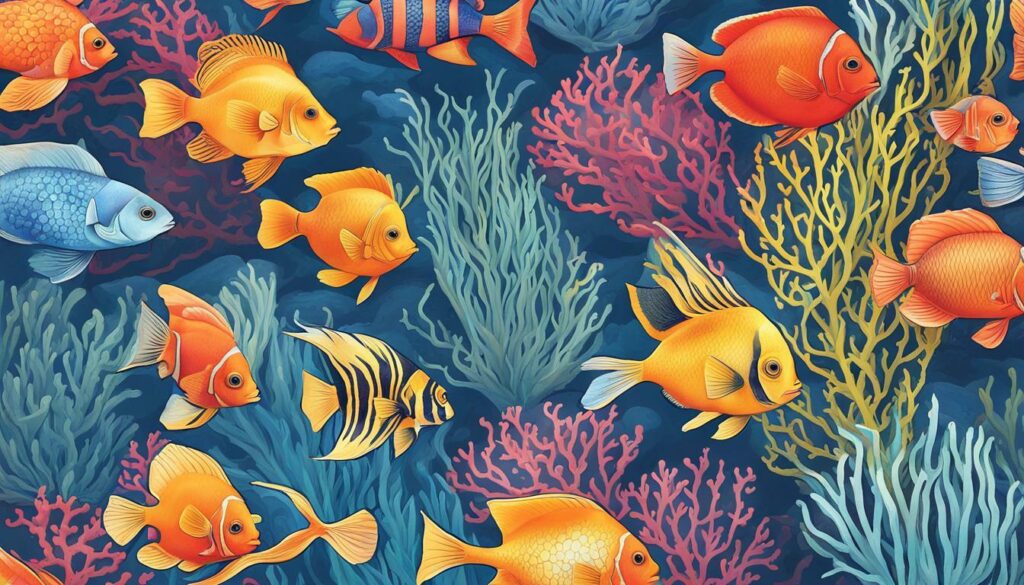
“Proper care and maintenance are essential for the health and well-being of aquarium fish and coral.”
Troubleshooting Common Issues
Despite our best efforts, aquarium fish and coral can sometimes encounter problems. Here we’ll discuss some common issues and provide solutions for maintaining healthy fish and vibrant coral.
Algae Growth
Algae growth can be caused by a number of factors, including excess nutrients, poor lighting, and irregular water changes. To prevent algae growth, ensure that your aquarium is receiving the correct amount of light, and perform regular water changes. If algae growth persists, consider reducing the amount of food you are feeding to your fish, or invest in an algae-eating fish species.
| Issue | Solution |
|---|---|
| Excess Nitrate and Phosphate | Perform regular water changes, and consider using live plants or other natural solutions to absorb excess nutrients. |
| Poor Water Circulation | Invest in a quality water pump or powerhead, and ensure that the water is circulating properly throughout the tank. |
| Dirty Filter | Clean or replace your filter regularly to ensure that it is functioning properly. |
Diseases
Diseases can be caused by a variety of factors, including poor water quality, overcrowding, and stress. To prevent the spread of diseases, quarantine new fish before adding them to your aquarium, and maintain proper water quality and temperature. If you suspect a fish is ill, isolate it and treat it accordingly.
| Issue | Solution |
|---|---|
| Ich | Isolate the infected fish and treat the aquarium with a suitable medication for Ich. |
| Fungal Infections | Isolate the infected fish and treat the aquarium with a suitable medication for fungal infections. |
| Parasites | Isolate the infected fish and treat the aquarium with a suitable medication for common parasites. |
Other Challenges
Other challenges can arise, such as cloudy water or aggressive fish. To address these issues, perform regular water changes, maintain appropriate water parameters and provide plenty of hiding places for fish that are bullied. Consult with an expert if these challenges persist.

Beginner’s Guide to Aquarium Fish and Coral
If you’re new to aquarium fish and coral, congratulations on taking the first step to creating a beautiful and vibrant underwater world. We understand that starting a new hobby can be overwhelming, which is why we’ve put together this beginner’s guide to help you get started.
The first thing you need to consider when setting up your aquarium is the size. It’s important to choose a tank that’s big enough for your fish and coral to thrive. A general rule of thumb is to have one inch of fish per gallon of water, but it’s always best to research the specific needs of the species you plan to keep.
Next, you’ll need to select the best coral for beginners. Some of our top recommendations include mushrooms, polyps, and zoanthids, as these are hardy and easy to care for. Be sure to research the specific needs of each type of coral, including lighting and water flow requirements, to ensure they thrive in your tank.
When it comes to selecting fish, it’s important to choose species that are compatible with each other and with your coral. Some popular tropical fish for sale include neon tetras, guppies, and corydoras catfish. Again, be sure to research the specific care requirements of each species before adding them to your tank.
One of the most important aspects of caring for your aquarium fish and coral is maintaining water quality. This involves regularly testing the water for pH, ammonia, nitrite, and nitrate levels, and making any necessary adjustments. You’ll also need to perform regular water changes, typically every two to four weeks.
Finally, adding fish tank accessories such as plants, rocks, and driftwood can enhance the visual appeal of your aquarium and provide hiding places for your fish. Just be sure to choose accessories that are compatible with your coral and fish species.
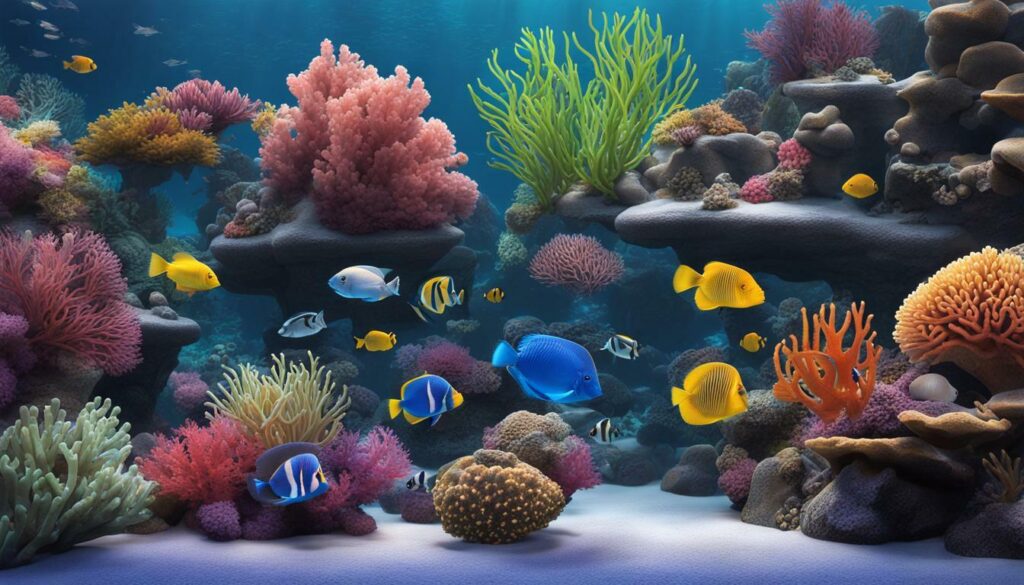
With these basic tips in mind, you’ll be well on your way to creating a thriving and visually stunning aquarium. Don’t be afraid to experiment and try new things along the way, and remember to always research the specific needs of your fish and coral to ensure they stay happy and healthy.
Expert Tips and Tricks
As experienced aquarium enthusiasts, we have learned a few tips and tricks along the way to help create stunning displays that not only are visually appealing but also ensure healthy fish and coral. Here are some of our top recommendations:
Choosing the Right Fish Tank Decorations
Selecting the right fish tank decorations is crucial in creating a beautiful and healthy aquarium. One important factor to consider is the size and type of decoration. Avoid overcrowding the tank with too many ornaments, which can create an unbalanced environment and harm the fish and coral. Also, make sure to choose decorations that are easy to clean and maintain.
Another important aspect to keep in mind is the compatibility of the decorations with the fish and coral species in the tank. For example, if you have delicate coral, avoid sharp or abrasive decorations that can damage them. It’s essential to create a harmonious environment for all the living creatures in the aquarium.
Mastering Water Quality
Water quality is paramount when it comes to the health and well-being of aquarium fish and coral. One way to maintain optimal water quality is by performing regular water changes. A general rule of thumb is to change about 10% of the water volume weekly or 25% monthly.
Monitoring the water parameters is also crucial. Use a reliable test kit to check the pH level, ammonia, and nitrate levels, and adjust if necessary. Additionally, invest in a high-quality filter that can handle the size and the number of living creatures in the aquarium. Proper filtration removes waste and toxins and ensures a healthy environment for the fish and coral.
Introducing New Fish and Coral
Introducing new fish or coral to an established aquarium can be challenging and risky. It’s essential to quarantine new arrivals for at least two weeks in a separate tank to ensure they are disease-free and acclimated to their new environment. Additionally, observe their behavior and health closely before adding them to the main tank. Avoid introducing too many new creatures at once, which can cause stress and unbalance the ecosystem.
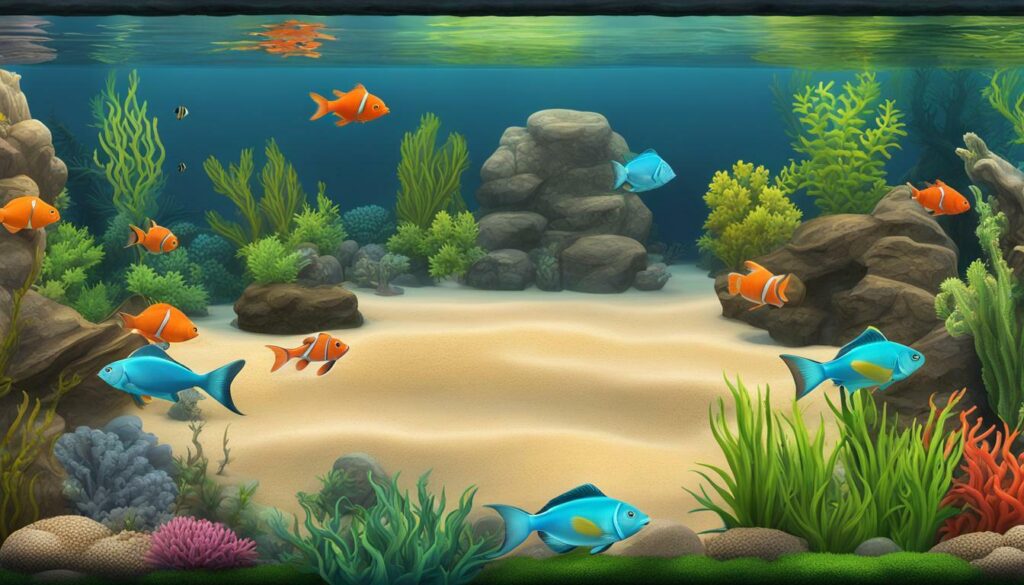
Troubleshooting Common Problems
Even with the best care, issues can arise in an aquarium. One common problem is algae growth, which can affect the water quality and visibility. Proper lighting, regular water changes, and controlling the feeding schedule can help prevent algae growth. If it does occur, you can remove it manually or introduce algae-eating fish or invertebrates.
Another common problem is fish diseases. Symptoms can include lethargy, loss of appetite, and abnormal behavior. Isolate the affected fish and treat them in a separate tank. Additionally, make sure to regularly clean the tank and avoid overfeeding the fish.
Creating an Aesthetically Pleasing Aquarium
Finally, creating a visually stunning aquarium requires creativity and attention to detail. Use a color scheme that complements the fish and coral in the tank. Experiment with different textures and sizes of decorations to create an interesting and dynamic environment. Consider the placement of decorations and the use of negative space to create focal points and depth. Finally, don’t be afraid to change things up periodically to keep the aquarium fresh and exciting.
The Benefits of Aquarium Fish and Coral
At our aquarium, we believe that the benefits of having fish and coral go far beyond their visual appeal. In fact, studies have shown that aquariums can have a positive impact on our overall well-being.
One of the most significant benefits is stress reduction. Watching fish swim peacefully in their habitat can help lower our heart rate and blood pressure, reducing stress levels and promoting relaxation.
Another benefit of having an aquarium is the educational value it provides. Children and adults alike can learn about different species of fish and coral, their unique characteristics and behavior patterns, and how to care for them properly.
Furthermore, aquariums can be a stunning focal point in any space, serving as a conversation starter and adding a touch of nature to the environment. They can also promote creativity and inspire imagination, especially when designing and decorating a new aquarium.
Lastly, taking care of fish and coral can be a fulfilling and rewarding experience. The responsibility of maintaining a healthy and thriving underwater ecosystem can provide a sense of accomplishment and purpose.

Overall, incorporating fish and coral into our lives can have numerous benefits, from promoting relaxation and education to serving as stunning visual displays and providing a sense of purpose.
Conclusion
We hope that our guide has helped you explore the wonderful world of aquarium fish and coral. From the beauty of fish tank decorations and live coral for sale to the importance of maintaining water quality and regularly maintaining fish tank accessories, there is much to learn and enjoy.
Whether you are a beginner or an experienced aquarium enthusiast, we encourage you to continue discovering new species, experimenting with creative displays, and sharing your passion with others. The benefits of aquarium fish and coral go far beyond aesthetics; they can also improve mental health, reduce stress, and serve as educational tools for people of all ages.
Thank you for taking the time to read our guide. We hope that it has inspired you to create a captivating underwater paradise that brings joy and relaxation to your life.
FAQ
Q: Can I mix saltwater and freshwater fish in the same aquarium?
A: No, it is not recommended to mix saltwater and freshwater fish in the same aquarium. They have different water requirements and it can be challenging to maintain the optimal conditions for both types of fish.
Q: How often should I feed my aquarium fish?
A: It is recommended to feed your aquarium fish once or twice a day, only giving them the amount of food they can consume within a few minutes. Overfeeding can lead to poor water quality and health issues for the fish.
Q: What is the best way to clean my aquarium?
A: Regular maintenance is important for a clean and healthy aquarium. You should perform partial water changes every 1-2 weeks, remove any debris or uneaten food, clean the glass and decorations with an aquarium-safe brush or scraper, and replace the filter media as needed.
Q: How can I prevent algae growth in my aquarium?
A: To prevent algae growth, you can take several steps, including reducing the amount of light your aquarium receives, keeping the water parameters stable, avoiding overfeeding, and adding algae-eating fish or snails to help control the algae population.
Q: What should I do if my aquarium fish show signs of illness?
A: If your aquarium fish show signs of illness, such as unusual behavior, loss of appetite, or physical symptoms, it is important to isolate the affected fish, test the water parameters, and consult with a veterinarian or experienced aquarium hobbyist for proper diagnosis and treatment.
Q: Can I keep live coral with aquarium fish?
A: Yes, you can keep live coral with aquarium fish. However, it is important to ensure that the coral species and fish species are compatible, and that the aquarium environment meets the specific requirements of both the coral and the fish.

